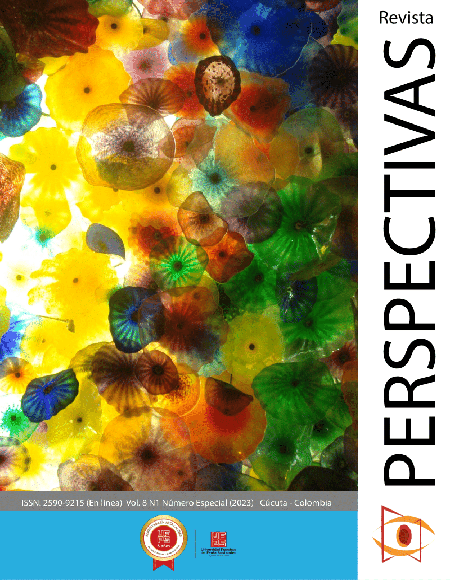Correlation of diameter-height of trees at the Universidad Francisco de Paula Santander,Cúcuta
Correlación de diámetro-altura de árboles en la Universidad Francisco de Paula Santander,Cúcuta
Main Article Content
In this article, a correlational study was carried out in order to analyze the normal diameter-total height relationship of the different tree species of the Francisco de Paula Santander University, Cúcuta headquarters. First, the data corresponding to normal diameter, total height and species were recorded. Then the species with more than eight individuals were identified for which the statistics were calculated: minimum and maximum values, arithmetic mean, variance and standard deviation. Next, the frequency of the intervals of both the normal diameter and the total height was determined. Subsequently, scatter diagrams were made and not only Pearson's linear correlation coefficient was calculated, but also the coefficient of determination, prediction error, hypothesis testing, and interpretation of the linear correlation coefficient. The results obtained indicated that the majority of individuals were found in the first two intervals of normal diameter, that is, smaller; on the other hand, most of the trees are found distributed in the first three intervals. It should also be mentioned that the variability of the data is shown, as well as the correlation between normal diameter and total height. In addition, the highest correlation coefficient was obtained by Palma Real, while the lowest was from Mamón. As a conclusion, it was obtained that the growth of the trees is subject to the relationship of the dasometric variables in addition to the environment in which they develop.
Downloads
Article Details
Alvarado, A., Guajardo, F., & Devia, S. (2014). Manual de plantación de árboles en áreas urbana. Santiago de Chile: Editorial Maval Ltda.
Arias, D. (2004). Estudio de las relaciones altura-diámetro para seis especies maderables utilizadas en programas de reforestación en la Zona Sur de Costa Rica. Kurú: Revista Forestal, 1(2), 1-11.
Baridón, J. E., Lanfranco, J. W., Marlats, R. M., & Vázquez, M.(2001). evaluación de la calidad de sitio forestal para Eucalyptus camaldulensis mediante índices edáficos en argiudoles y argiacuoles, Argentina. Agricultura Técnica, 61(2), 192-201. https://doi.org/10.4067/S0365-280720 01000200009 DOI: https://doi.org/10.4067/S0365-28072001000200009
Carvajal V., E. A., García C., H. J., & Carvajal A., M. A. (2021). Características diagnósticas, fenológicas, ecológicas y ambientales de las especies arbóreas de Cúcuta. Cúcuta: Universidad Francisco de Paula Santander. Recuperado de https://drive.google.com/file/d/1alREO VeNN2pMnQFeW7h3Wb_BcF3StOV 8/view?usp=embed_facebook
Carvajal V, E. A., Hernández D, Y. M., & Patiño C, P. A. (2021). Especies arbóreas de la Universidad Francisco de Paula Santander. Bogotá: Ecoe Ediciones.
Dávila, D. E., Franco, J., & Ospina, R. (2012). Distribución Espacial, Estructura y Volumen de los Bosques de Roble Negro (Colombobalanus excelsa (Lozano, Hern. Cam. & Henao, J. E.) Nixon & Crepet) en el Parque Nacional Natural Cueva de los Guácharos. Colombia Forestal, 15(2), 207-2014. DOI: https://doi.org/10.14483/udistrital.jour.colomb.for.2012.2.a05
Diéguez, U., Castedo, F., Barrio, B., Álvarez, J. G., Rojo, A., & Ruiz, A. D. (2005). Prácticas de Dasometría. Recuperado de
https://www.researchgate.net/profile/A lberto-Rojo-Alboreca/publication/3056 40101_Practicas_de_dasometria/links/ 5797266408ae33e89faea3f8/Practicas- de-dasometria.pdf
Esri Story Map. (s. f.). Story Map Series. Recuperado de https://www.arcgis.com/apps/MapSeri es/index.html?appid=3969aa8a1b2043 f8bbc7c394c1e57fad
Fallas, J. (2012). Correlación lineal Midiendo la relación entre dos variables. Recuperado de https://www.ucipfg.com/Repositorio/ MGAP/MGAP-05/BLOQUE-ACADEMICO/Unidad-2/complementarias/corr elacion_lineal_2012.pdf
Gadow, K. V., Sánchez, S., Álvarez, J. G. (2007). Estructura y Crecimiento del Bosque. Göttingen, Alemania: Universidad de Göttingen.
Gardiol, M. R. (2014). Determinación de Dimensiones Morfométricas en Especies Arbóreas por Medio de Fotografías Aisladas. Contribuciones Científicas GAEA, 26, 119-127.
Recuperado de: http://gaea.org.ar/contribuciones/Contr ibuciones2014/Gardiol.pdf Grupo Intergubernamental de Expertos sobre el Cambio Climático. (2013). Bases físicas. Resumen para responsables de políticas, Resumen técnico y Preguntas frecuentes. Cambridge: OMM/PNUMA. Recuperado de https://www.ipcc.ch/site/assets/uploads/2018/03/WG1AR5_SummaryVolume_FINAL_SPANISH.pdf
Guzmán, J. C., Aguirre, O. A., González, M. A., Treviño, E. J., Jiménez, J., Vargas, B., Santos, H. M. D., Guzmán, J. C., Aguirre, O. A., González, M. A., Treviño, E. J., Jiménez, J., Vargas, B., & Santos, H. M. D. (2019). Relación altura-diámetro para Abies religiosa Kunth Schltdl. & Cham. En el centro y sur de México. Revista mexicana de ciencias forestales, 10(52), 99-120. https://doi.org/10.29298/rmcf.v10i52.4 83 DOI: https://doi.org/10.29298/rmcf.v10i52.483
Hernández, J. D., Espinosa, F., Rodríguez, J. E., Chacón, J. G., Toloza, C. A., Arenas, M. C., Carrillo, S.M., & Bermúdez, B. J. (2018). Sobre el uso adecuado del coeficiente de correlación de Pearson: Definición, propiedades y suposiciones. Archivos Venezolanos de Farmacología y Terapéutica, 37(5), 587-601.
Hernández, Y. M., & Patiño, P. A. (2017). Plan de manejo del arbolado ornamental de la Universidad Francisco de Paula Santander, sede Cúcuta 2018 (Tesis de pregrado, Universidad Francisco de Paula Santander). Recuperada de https://repositorio.ufps.edu.co/bitstrea m/handle/ufps/2046/1650326.pdf?sequ ence=1&isAllowed=y
Juárez, M., Pece, M. G., Gaillard, C., Sanguedolce, J., Mariot, V., & Mazzuco, R. (2007). Ecuaciones altura-diámetro en Prosopis nigra (Griseb) Hieron (algarrobo negro) en Santiago del Estero, Argentina. Foresta Veracruzana, vol. 9(1), 9-14
Instituto de Hidrología, Meteorología y Estudios Ambientales, (s.f.). Atlas Climatológico de Colombia1981 – 2010. Recuperado de http://atlas.ideam.gov.co/visorAtlasCli matologico.html
Instituto de Hidrología, Meteorología y Estudios Ambientales, (s.f.). Clasificación de los climas. Recuperado de
http://atlas.ideam.gov.co/basefiles/clim a-text.pdf
Martínez-López, J., & Acosta-Ramos, A. (2014). Estimación del diámetro, altura y volumen a partir del diámetro del tocón para Quercus laurina, en Ixtlán, Oaxaca, México. Madera y Bosques, 20(1), 59-70. DOI: https://doi.org/10.21829/myb.2014.201176
Oficina de Planeación. (2010). Plan de Infraestructura Física Universidad Francisco de Paula Santander 2011-2019. Universidad Francisco de Paula Santander.
Quiñónez, G., Cruz, F., Vargas, B., & Hernández, F. J. (2012). Estimación del diámetro, altura y volumen a partir del tocón para especies forestales de Durango. Revista mexicana de ciencias forestales, 3(9), 23-39. DOI: https://doi.org/10.29298/rmcf.v3i9.535
Wabo, E. (2002). Capítulo 2: Medición de Diámetros, Altura y Edad del Árbol. Recuperado de:
https://aulavirtual.agro.unlp.edu.ar/plu ginfile.php/50972/mod_folder/content/ 0/WABO%20Diametros.pdf?forcedow nload=1







